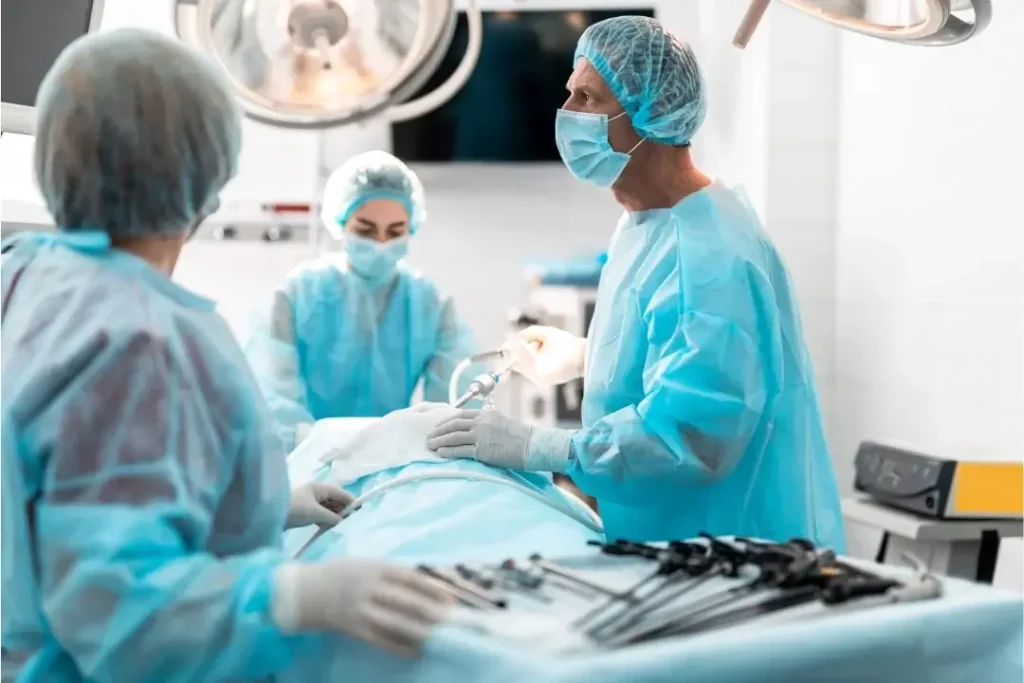
Early Pregnancy Signs 21 Symptoms Women Miss
Am I Pregnant? Early pregnancy signs You Should Never Ignore (Pakistan + Overseas Guide) Early pregnancy can feel like a puzzle. Some women feel symptoms

“Laparoscopic Gynecological Surgery, A Mindblowing Surgery Procedure with no Pain or Cut & Fast Recovery Process”
Laparoscopic Gynecological Surgery, is a phrase that has probably crossed your path if you’re exploring options in the gynecology world. As an experienced gynecologist and obstetrician, I, Dr. Rafiya Zahir, believe in informing my patients about their options so they can understand which procedure is best for them. This blog aims to describe laparoscopic surgery, shedding light on its benefits, procedures, and post-surgery care, among other essential aspects. So.let’s begin our informational blog!
Laparoscopic Gynecological Surgery, often referred to as ‘keyhole surgery’, is a minimally incursive surgical procedure that permits surgeons to access and operate on areas such as the pelvis and stomach without having to make vauntingly incisions. The process involves making several small incisions, into which a laparoscope (a long, slim down instrument with a high-resolution camera and a high-intensity light at the front) is inserted, providing a clear watch of the surgical site.

Laparoscopic Surgery offers numerous advantages over traditional surgical methods. Primarily, due to the minimal invasiveness, patients experience to a lesser extent post-operative discomfort, reduced scarring, and faster retrieval times. This surgery is particularly beneficial for addressing gynecological issues, as it allows for the precise handling of delicate reproductive organs, leading to less tissue damages issue and reduced risk of infection.
There are several procedures that can be performed using laparoscopic surgical methods, including:
Each of these procedures has its own unique benefits and considerations, which will be discussed in detail with patients before the surgery.
Laparoscopic Surgery is widely used to diagnose and treat a range of gynecological conditions, such as:
These conditions can often present significant health issues and discomfort for women, making laparoscopic surgery an essential tool in the gynecological field.
The process of laparoscopic surgery involves the use of specialized tools, such as a laparoscope, which is equipped with a camera and light source for enhanced visibility. The surgeon also utilizes long, thin instruments that are inserted through the additional incisions to perform the necessary surgical actions. The entire procedure is monitored on a digital screen, allowing the surgeon to execute precise movements with high accuracy.
Like any surgical procedure, laparoscopic surgery does carry some risks and potential complications. These may include:
It’s important to note that these risks are relatively very low and can be managed effectively under the care of an experienced surgeon. Your surgeon will discuss these potential complications with you in detail before the procedure.

As a gynecologist, I often recommend medical specialty laparoscopy to my patients for several reasons. The key reason for opting for this procedure is when non-invasive methods such as ultrasound, MRI, or CT scans are unable to provide enough information or when these methods suggest an abnormality that needs further investigation. The subprogram can be diagnostic, helping to place issues such as unexplained pelvic pain, infertility, or an unexplained mass. Conditions like endometriosis, fibroids, and ovarian cysts can also be known through laparoscopy. Additionally, therapeutic laparoscopy put up be used to treat a variety show of gynecological conditions, minimizing the need for any other big invasive procedures.
Following Laparoscopic Surgery, many patients return to their normal subprogram within two weeks. The recovery period of time is generally much shorter than traditional open surgery due to the minimally incursive nature of the procedure. However, the exact recovery clock can vary depending on the individual patient’s overall health and the particular subroutine performed. pursuit surgery, it’s wise to take ample rest, maintain a sound diet, and regularly follow up with your treating doctor. It’s vital to be reminiscent of any unusual signs such as severe pain, inordinate bleeding, or high fever, and account them to the doctor immediately.
In conclusion, Laparoscopic Surgery is an extraordinary breakthrough in the sphere of gynecology and obstetrics. Not only does it volunteer a to a lesser extent invasive alternative to other operative methods, but it also importantly reduces recovery time, minimizing disruption to the patient’s life. Moreover, its application spans a wide range of gynecological conditions, providing relief to countless women. Through this blog, I hope to have provided comprehensive information on Laparoscopic Surgery, its benefits, procedures, and retrieval process. As a wrapped-up gynecologist, my missionary work is to ensure every woman has got at to the best healthcare solutions, and the Laparoscopic surgical process certainly holds a pivotal place in this regard.
Before the procedure, patients are ordinarily asked to fast for some hours. An anesthetist wish discusses the type of anesthesia to be used. Additionally, careful blood tests and imaging studies may be required to ensure that the patient is accommodated for surgery.
The duration of the procedure can vary greatly depending on the nature and complexity of the surgery. Typically, the surgery put up time anywhere between 30 minutes to several hours.
After the procedure, the patient is generally advised to keep off energetic activities and heavy lifting for a few weeks. Sexual intercourse should also be avoided until given instructions by the treating doctor.

Am I Pregnant? Early pregnancy signs You Should Never Ignore (Pakistan + Overseas Guide) Early pregnancy can feel like a puzzle. Some women feel symptoms

How to Prepare for Your First Pregnancy: The Complete Doctor Backed Guide for Pakistani & Overseas Pakistani Women “Planning Your First Baby? Follow This Doctor

6 STUDIED-BASED TIPS FOR NORMAL DELIVERY IN 9th MONTH, PREGNANT WOMEN NEED TO KNOW Are you in your 9th month pregnant women and you want

Doctor sahiba, mujhe PCOS hai ya PCOD? Many Pakistani women hear these terms and feel confused: “PCOD ya PCOS? Dono mein farq kya hai?” It’s

Tired of Summer Swelling? Discover the Safest Daily Exercises to Reduce Edema Naturally Have you ever felt like your feet or hands were getting a

Heart Palpitations from Heat? This Breathing Hack Could Be the Relief You’ve Been Missing Did you ever feel your heart racing or fluttering after getting
Please provide your details below, and we will contact you after you schedule your appointment.